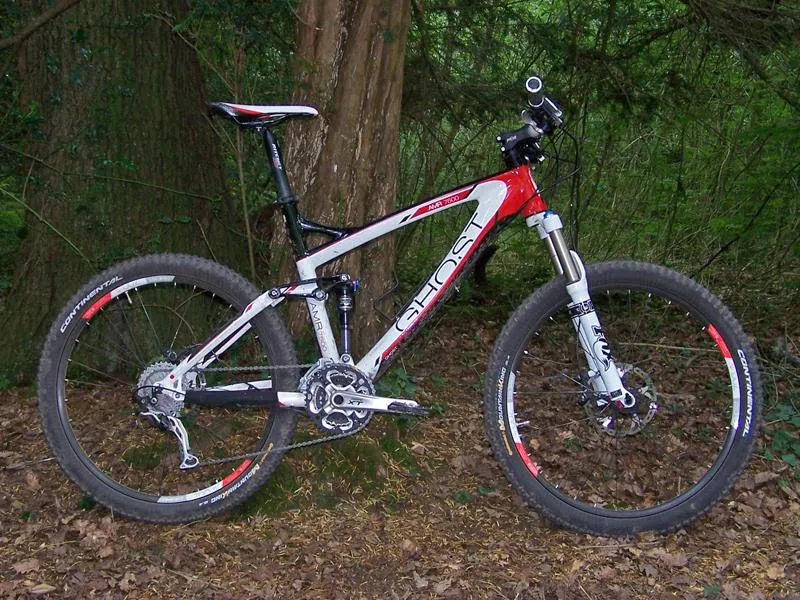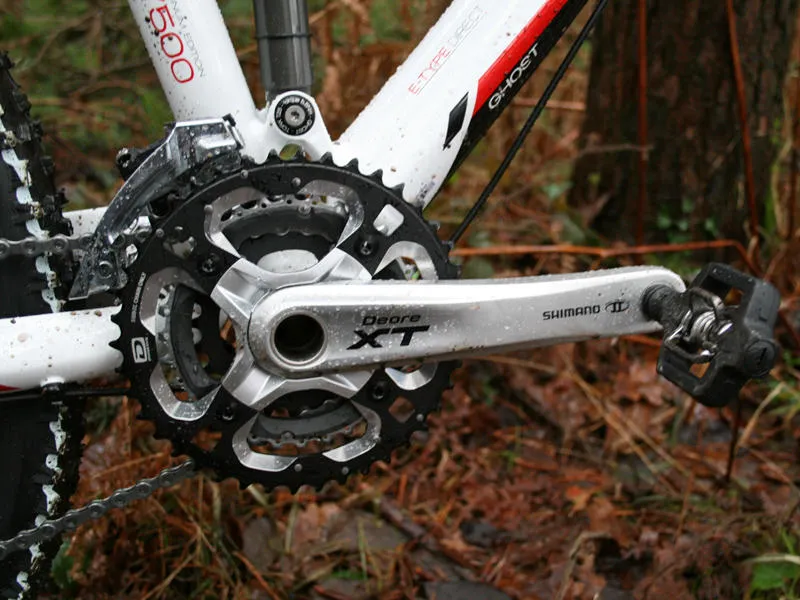The 120mm-travel AMR is one of those bikes that just feels right when you sit on it, with a stiff, well proportioned frame, supple suspension and a quality parts pick. We’ve had it in our test fleet for six months now and we’ve had a blast every time we’ve taken it out.
Ride & handling: Sorted trail all-rounder
There’s no particular area where the Ghost excels – it’s not a demon descender like the Lapierre Zesty, its suspension is very good but not quite up there with the Trek Fuel EX8, and it can’t beat the Canyon Nerve XC 9.0 for out-and-out value. However, that doesn’t mean it’s not a worthy contender for your cash.
Where the AMR impresses is with its all-round ability, with a confidence-inspiring ride and reassuringly neutral handling that’ll suit beginners and experienced riders alike. Add a tough, good looking frame and a spec list filled with kit that’ll last the distance, and you’ve got a sorted package.
Words like ‘neutral’ and ‘stable’ can make a bike sound boring, but that’s not the case here. It’s just that there are no handling quirks to make technical sections a chore rather than a challenge. Instead, the AMR remains composed, whatever you throw at it.
It’s more a trusty workhorse than a fancy but flighty thoroughbred – largely due to its weight; more on this below – but it pedals well and at the end of a long day in the saddle or when you’re pinballing through rocks, that stability and poise shows its true value.
There’s no hint of flex from the beefy front triangle and the through-axle fork adds to excellent steering accuracy. Stick on some ProPedal platform damping and it’ll handle a bit of enduro cross-country racing, or run the rear shock fully open for a surprisingly plush feel on the downhills.
The trail centre is the AMR’s natural hunting ground, where its four-bar rear end smoothes out the stutter bumps and sucks up the hits, and its tracking accuracy ensures you continue to steer a tight course while those on lighter, flexier bikes are sent ricocheting off rocks and roots.

The AMR's FSR-style four-bar rear end provides a plush feel but pedalling remains efficient
We’ve had the 7500 on test for six months now and we’ve had no problems apart from a snapped chain (and that was our own fault). There was a hint of play at the rear from new, but UK distributors Hotlines assure us this was due to a manufacturing issue with the top shock bushing which has since been sorted. It hasn’t got appreciably worse over time.
The only thing holding this bike back is its weight – at 28.96lb/13.13kg for the 52cm size, the AMR 7500 is slower off the mark than some of its lighter price rivals and harder work up the hills. That said, it’s by no means the heaviest bike in its category and it doesn’t feel heavy when you’re in the saddle.
In some ways this heft is reassuring – most of the weight is in the frame, not the parts, backing up Ghost’s assertion that they prioritise performance and durability over gram shaving. Apparently, this is reflected in an extremely low rate of warranty claims. However, it means component upgrades are likely to save grams rather than pounds, so weight weenies should probably look elsewhere.
We’d recommend casting an eye over the rest of the AMR range before forking out for a 7500. The £2,750 AMR Lector 7700 upgrades to a carbon fibre front end, bar and seatpost, saving 600g and addressing our main criticism of the 7500 – excess weight – in the process. Kit is the same as on the 7500
If you’re on a tight budget, the next-step-down alloy AMR, the 5900, has the same frame, fork and shock as the 7500, but costs £300 less. The most obvious downgrade is use of slightly heavier SLX rather than XT kit, but you also get a quick-release rather than through-axle front wheel, which won’t suit more aggressive riders.

The tapered head and through-axle fork contribute to a tight-tracking front end
Frame & equipment: Well thought out chassis and quality kit
With its tapered 1-1/8 to 1-1/2in head tube, press-fit bottom bracket and chunky hydroformed tubing, the AMR is clearly aimed at the baggy shorts brigade rather than Lycra lovers. Full-length outer cabling is a bonus if you regularly ride in wet conditions.
Out back, there’s a four-bar linkage with FSR-style chainstay pivot; a proven suspension design known for its plush ride. Ghost use a needle bearing in the upper shock eyelet instead of a bushing to reduce stiction and provide an extra-supple ride over small bumps.
Another unusual feature of the German company’s bikes is SCL – Size-specific Chainstay Length. In other words, different frame sizes get different length rear ends as well as front triangles. Sounds sensible, but very few other companies do this. The 69-degree head angle gives decent downhill stability without causing the front end to wander on climbs.
Ghost stick with a proven Fox 32/RP23 Boost Valve suspension combo for the AMR, and it works a treat. The FIT cartridge fork isn’t as supple-feeling as the rear, but it remains composed when the hits start to come hard and fast. The drivetrain is 10-speed Shimano XT, which gives slick, accurate shifts every time. Brakes are also XT and proved consistent and reliable.
The 100mm Ritchey stem and 670mm bar are a bit old-school; we swapped to a shorter and wider combo to give a more aggressive feel and more control on technical terrain. This really helped the AMR to shine on tight, twisting singletrack and high-speed downhills. The good news is that a wider bar will come as standard on the 2012 bike, which also drops in price by £100.
Schwalbe Nobby Nic 2.25ins are a favourite of many BikeRadar testers, but the hard compound wasn’t ideal for our test trails and we felt the Ghost’s plush rear end warranted some higher-volume treads. We initially subbed in some Bontrager XR4 Team Issues, but in a 2.35in width they turned the AMR into a trundler so we switched to some Continental Mountain King IIs instead.
Despite being nominally 2.4in wide, these were actually a lot narrower than the Bontys and offered a good compromise between comfort- and traction-adding volume and rolling speed. An obvious upgrade for the Ghost would be tubeless tyres, which would shave a pound or so off the overall weight and allow you to run lower pressures with less risk of puncturing.
The AMR’s chunky grips were a love/hate affair and the saddle didn’t suit all posteriors, with a very hard initial feel which did soften a bit over time. We'd also question the wisdom of speccing a white seat on a mountain bike. Overall, though, the parts are good for the price and apart from personal-preference items like the bar and stem there’s nothing we’d recommend upgrading at point of sale.

The AMR 7500 at the start of our test period, with its stock spec

By the end of our test period we'd swapped to a wider bar, shorter stem and bigger tyres





